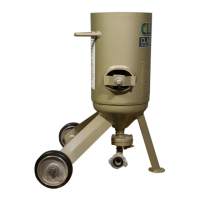MODELS 1028 & 1042 BLAST MACHINES Page 3
© 2013 CLEMCO INDUSTRIES CORP. www.clemcoindustries.com Manual No. 04124, Rev. K
Compressed Air and Abrasives Consumption
Consumption rates are based on abrasives that weigh 100 pounds per cubic foot
Pressure at the Nozzle (psi) Air, Power
Nozzle and Abrasive
Orifice Size (inch) 50 60 70 80 90 100 Requirements
11 13 15 17 19 20 Air (cfm)
No. 2 (1/8 inch) 67 77 88 101 112 123 Abrasive lbs/hr)
2.5 3 3.5 4 4.5 5 Compressor (hp)
26 30 33 38 41 45 Air (cfm)
No. 3 (3/16 inch) 150 171 196 216 238 264 Abrasive (lbs/hr)
6 7 8 9 10 10 Compressor (hp)
47 54 61 68 74 81 Air (cfm)
No. 4 (1/4 inch) 268 312 354 408 448 494 Abrasive (lbs/hr)
11 12 14 16 17 18 Compressor (hp)
Air requirements were measured by a flow meter under actual blasting conditions, and are therefore lower than figures
for air alone, with no abrasive.
Horsepower requirements are based on 4.5 cfm per horsepower.
Figures are for reference only, and may vary for different working conditions. Several variables, including metering valve
adjustments, can affect abrasive flow.
Figures show approximate compressed air and abrasive consumption when nozzles are new. Consumption will increase
as the nozzle wears.
Figure 2
and is under such positive control that the pressure
in the vessel cannot exceed the maximum allowable
working pressure at the operating temperature...".
OSHA regulation 1910.169 refers to the above ASME
code when describing the necessity of pressure relief
valves on compressed air equipment. DO NOT operate
blast machines with air compressors that are not
equipped with properly functioning pressure relief
valves.
(1)
American Society of Mechanical Engineers, Boiler and Pressure
Vessel Code, 1989
(2)
Occupational Safety and Health Administration, 29 CFR 1910,
Subpart M - Compressed Gas and Compressed Air Equipment.
1.3.6 Compressed-air Requirements
1.3.6.1 The size of the compressor required depends on
the orifice size of the nozzle and blasting pressure.
Unless otherwise specified, blast machine packages are
supplied with a 1/4" orifice nozzle. Nozzles larger than
1/4" are not recommended because they will rapidly
wear the 1/2" blast hose used with these machines.
1.3.6.2 Refer to the table in Figure 2 to determine cfm
requirements. The table shows air consumption of
nozzles when new. It does not show the recommended
compressor size. As nozzles wear, they will consume
70% to 80% more air. Consult with a compressor
supplier for suggested compressor size based on the air
consumption of the next larger orifice size.
1.3.7 Remote Controls
1.3.7.1 Separate manuals are provided for the
operation, maintenance, and replacement parts for the
TLR-50 remote controls (Manual Stock No. 03358) and
RLX control handle (Manuals Stock No. 10574). Refer to
those manuals for set-up and operation of the remote
control system.
1.3.8 Air Filter, Optional
1.3.8.1 The optional air filter at the blast machine inlet
removes water condensed in the compressed air line. Its
use is especially important in areas of high humidity, or
when fine-mesh abrasive is used. Moisture causes
media to clot and inhibits free flow through the metering
valve. See Section 7.1 for accessories. If moisture
problems persist, an air dryer may be required.

